#sipde
Explore tagged Tumblr posts
Text
Safe Drivers:
• Monitor other road users and traffic-
control devices
• Observe and anticipate the actions of other drivers, pedestrians, cyclists, and animals
• Know and comply with traffic regulations
• Control their vehicle under all types of weather and road conditions
Behaviors that "safe" drivers show.
In addition, they also:
• Decide how to effectively respond to various situations and assess the consequences of alternative responses
• Initiate action and apply adjustments as necessary
• Constantly repeat this process
Anticipate, prevent, and manage additional demands of the road, including:
• Increased speed
• Dense traffic
• Inclement weather
• Distractions
• Stress
• Fatigue
We can learn to not attempt to make a last-minute turn under a yellow signal light
Never assume anything about another driver - better yet: assume they will do the thing that puts you at the most risk
If your view is blocked, anticipate that there is something behind whatever is blocking your view
Also, consider avoiding making unprotected left turns—they are trouble!
Let's Review
• Remember to READ the road
• Keep attention on the road
• Never assume anything about another driver
• Anticipate hazards
• Do not look away from the road for more than 2 seconds
• Never assume a crosswalk is empty
There are three steps to reducing risk:
Perceive
Decide
Act
Perceive
Perceive everything in the traffic scene by:
• Searching 20 to 30 seconds ahead along your intended path of travel for objects and conditions that could increase risk
• Being aware of available traction on the road surface
• Identifying an alternate path of travel 12 to 15 seconds ahead so you can steer out of trouble if a threatening situation develops
Decide
Use the information gathered from your visual search to make wise decisions. This includes:
• Anticipating the possible actions of other road users that could affect your risk
• Assessing the consequences of alternative responses
• Determining the best course of action
Act
Carrying out your actions and maneuvers can involve:
• Changing speed by decelerating, braking, or accelerating
• Adjusting position or direction by changing lanes or turning
• Communicating with other road users
• A combination of two or more of the above
• You should hold off driving up alongside the truck until there is a full car length of space open ahead of the truck in your lane
That way, you can move by and be in a safe space ahead of the truck.
• Avoid driving alongside a truck for a second more than you have to
IPDE
Identify → Predict → Decide → Execute
In this model, predict refers to the task of anticipating what another road user might do, in case you need to respond to a maneuver
SIPDE
Search → Identify → Predict → Decide → Execute
Here, search (or scan) refers to the fact that drivers should be active in their visual search, moving their eyes in a consistent way to maximize their perception
SEE
Search → Evaluate → Execute
Set is an alternate process that describes how drivers should perceive and respond to the traffic scene to minimize risk
Of the three steps, which is the most important?
The first step, perceiving, is the most important
If you don’t perceive something, you never even make it to the Decide or Act step
If you don’t see it, there’s no reason your brain would make a decision about it
That is, if you fail at step one, you never even get to steps two and three
Most roads feature marked travel lanes that are 10 to 12 feet wide
If lanes are not marked, imagine a 12-foot-wide carpet rolled out ahead of your vehicle
You can use this imaginary path for steering and control, but take care to use it only as a reference point
Never allow your eyes to become fixed on any one point or object; rather, keep them active and moving

Position 1 - Center
Centered in the lane is the most appropriate for most driving situations
Position 2 - Left of center
Positioning left of center is most helpful when a vehicle, bicyclist, or emergency vehicle is on the right shoulder
Position 3 - Right of center
Positioning right of center would be most helpful when large oncoming vehicles approach or when you are preparing to turn right
Perception Time
Perception time is the time it takes for a driver to see something, such as an obstruction in the road ahead
Braking Time
Braking time is the time required to slow the vehicle to a safe speed or to stop, as when the travel path is blocked and there is no alternative path
Reaction Time
Reaction time is how long it takes for the driver to act after recognizing a hazard and deciding to respond
For example, the stopping distance from 40 mph is not just double the stopping distance from 20 mph, it is much longer
Closing Probability
The chance that a vehicle and another road user will move closer together as they move along projected paths of travel
Closing Action
The actions road users execute that increase closing probability changing lanes, entering an intersection or a pedestrian walking into the street from between parked cars
There are four actions drivers can and do execute when responding to driving environments and situations
Changing speed (coasting, braking or accelerating)
Changing direction or position (turning; changing lanes)
Communicating (using the horn, flashing headlights, etc.)
A combination of two or all of the first three (3) actions
Errors
Vision and Perception Errors
• Allows vision to be diverted from
the path of travel
• Allows vision to be blocked
• Does not establish eye contact with other road users when potential conflict situations develop
• Fails to check rearview mirrors and mirror blind zones
Not Yielding Right-of-Way
• Does not obey STOP or YIELD signs
• Runs red traffic signals
• Does not yield to the driver on the right side at an intersection
Improperly Adjusting Speed
Approaches STOP or YIELD signs at too high a speed
Approaches and enters turn too fast
Drives through curves at excessive speed
Does not adjust speed to compensate for reduced visibility, traction, or space
Poorly Judging Distance or Space Requirements
Follows other vehicles too closely
Swings wide or turns too sharply
Passes or overtakes other vehicles improperly
Selects improper lane or position when turning
Inadequate or Improper Vehicle Control
Brakes suddenly or steers too quickly on a low-traction surface
Steers through turns poorly (e.g., hits curb with inside wheel)
Uses the improper seating position
Improper Signaling
Fails to signal when turning or changing lanes
Improperly or inappropriately uses four-way emergency flashers
Gives a false or misleading signal
Improper Timing
Fails to adjust speed to deal with only one hazard at a time
Underestimates spacing between conflicts
Lack of attention and focus on timing
You should give bicyclists at least 3 feet of space. Some state laws require at least 4 feet of space
The law requires drivers to factor in visibility, traction, the volume and speed of nearby traffic and not to exceed reasonable and prudent speeds
You must be aware of prevailing conditions and drive accordingly, allowing yourself a clear distance ahead in which to stop if necessary
What determines a safe driving speed?
The distance ahead that you can see along your projected path of travel
For example, if you can see ahead only 200 feet because of fog or heavy rain and are traveling at 55 mph. you have not left yourself the 235 to 275 feet needed to stop safely
You must reduce your speed.
It takes the brain ½ to ¾ of a second to process information
Plus, most control actions take about ½ a second, such as starting to turn the steering wheel or beginning to apply the brakes
Tip: If you see a person ahead of you driving erratically, maintain a space of at least 4 to 5 seconds - more is better
With large vehicles, maintain a space of at least 6 seconds, and identify an alternate escape path in case you need one
When faced with dangers close to both sides of your pathway, you allow:
More space to the side with the more serious consequences
When you are driving, it is most difficult to control the space to your:
Rear
Of the options presented, which is the most effective for maintaining space around your vehicle?
Speed
Your intended path of travel is the space into which you can safely direct your vehicle with the least risk
True
A "closing probability" when driving is:
The chance that a vehicle and another object will move closer together as they move along projected paths of travel
When dealing with tailgaters it is best to:
Slow down and let them pass by
When a vehicle moves into your space you should:
Safely maneuver to re-establish your space
In traffic, the best way for you to provide an emergency escape path is to maintain adequate space to the:
Front and at least one side of your vehicle
Weather
It is very foggy. You should slow down and:
Turn your lights to their low beam setting
When driving in thick fog with very bad visibility, the safest option is to:
Pull off the road and stop, using your emergency flashers
Water on the road can cause a vehicle to hydroplane. Your car may hydroplane at speeds as low as:
35 miles per hour
1 note
·
View note
Text
WAKIL Bupati Samosir, Sumatera Utara, Ariston Tua Sidauruk resmi membuka Sosialisasi dan Bimbingan Teknis (Bimtek) Implementasi Sistem Informasi Pemerintahan Daerah Republik Indonesia (SIPD-RI) di Ballroom Marianna Resort & Convention, Tuktuk Siadong, Kecamatan Simanindo, Kamis (12/6).
Kegiatan yang diinisiasi PT Bank Sumut bekerja sama dengan Kementerian Dalam Negeri itu diikuti Kepala BKAD, BPKPD, BPKPAD, BPKAD, dan BUD dari provinsi dan kabupaten/kota se-Sumatera Utara. Agenda berlangsung dua hari, 12–13 Juni 2025, sekaligus dirangkai dengan uji operasional SIPD-RI dan penandatanganan kerja sama dengan seluruh pemerintah daerah.
“Atas nama Pemkab Samosir, kami menyambut baik seluruh peserta di negeri indah kepingan surga, titik awal peradaban Batak,” ujar Ariston dalam sambutannya.
1 note
·
View note
Text
Bimtek Sistem Informasi Pemerintahan Daerah (SIPD RI)
Jadwal Bimtek Nasional – Bimtek Sistem Informasi Pemerintahan Daerah (SIPD RI) Sistem Informasi Pemerintahan Daerah (SIPD) merupakan amanat dari UU 23 Tahun 2014 Pasal 391 dimana Pemerintah Daerah wajib menyediakan Informasi Pemerintahan Daerah, yang dikelola dalam suatu Sistem Informasi Pemerintahan Daerah. Penggunaan SIPD dipertegas melalui Permendagri Nomor 70 tahun 2019 tentang Sistem…
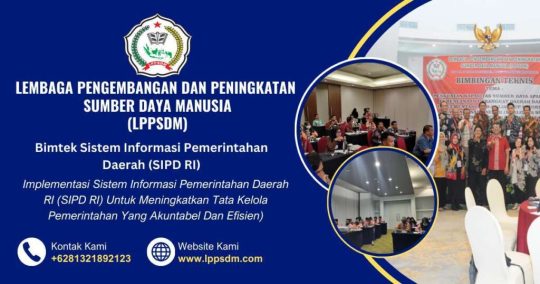
View On WordPress
0 notes
Text
Sosialisasi SIPD dan e-Walidata di Bengkulu Tengah: Transparansi dan Akurasi Data Pemerintahan Daerah
Sosialisasi SIPD dan e-Walidata di Bengkulu Tengah: Transparansi dan Akurasi Data Pemerintahan Daerah KANTOR-BERITA.COM, BENGKULU TENGAH|| Pemerintah Kabupaten Bengkulu Tengah, melalui Badan Perencanaan Pembangunan Daerah (BAPPEDA) dan Dinas Komunikasi Informatika dan Statistik (Diskominfotik), menyelenggarakan sosialisasi teknis penginputan e-Walidata dan Rencana Pembangunan Jangka Panjang…
#Diskominfotik#e-Walidata#Implementasi Satu Data Indonesia#Optimalisasi#Penggunaan platform#penginputan e-Walidata#sipd.go.id#Sosialisasi SIPD#Transparansi data#Bengkulu Tengah#Heriyandi Roni#RPJPD
0 notes
Text
January Salary for Bone Bolango Regency Civil Servants Begins Disbursement
January Salary for Bone Bolango Regency Civil Servants Begins Disbursement #JanuarySalary #BoneBolango
Hargo.co.id, GORONTALO – The Bone Bolango Regency Government, represented by the Regional Financial and Revenue Agency (BKPD), will start disbursing civil servants’ salaries (ASN) for January 2024. “As of today, Thursday, January 4, 2024, ASN salaries for January will be gradually disbursed,” said Head of BKPD Bone Bolango, Iwan Mustapa. With the commencement of the payment of ASN salaries, Iwan…

View On WordPress
#ASN#BKPD#Bonebolango#DataReadiness#FinancialManagement#JanuarySalary#LocalGovernment#MinistryOfHomeAffairs#SalaryDisbursement#SIPD#SuccessfulTrial#SystemChallenge
0 notes
Text
Global Breakthrough: ... effective, inexpensive, and simple COVID-19 vaccine that can be stored at room temperature and administered as a nasal spray
News Release 21-Nov-2024
Peer-Reviewed Publication
Prof. Ronit Satchi-Fainaro's lab at TAU's Faculty of Medical and Health Sciences collaborated with Prof. Helena Florindo’s lab at the University of Lisbon to produce a novel nano-vaccine for COVID-19.
The nano-vaccine, a 200-nanometer particle, trains the immune system against all common COVID-19 variants, just as effectively as existing vaccines. Moreover, unlike other vaccines it is conveniently administered as a nasal spray and does not require a cold supply chain or ultra-cold storage.
https://onlinelibrary.wiley.com/doi/10.1002/advs.202404159
Additionally, mice treated with siPD-L1 NV-8 (IN booster) exhibited enhanced GC responses (Figure 5O), consistent with the strong humoral and mucosal immunities also detected in this group. In contrast, the mRNA vaccine induced higher numbers of Tfh and Tfr cells (Figure 5O). Regarding antibody levels, both vaccines revealed similar IgG titers (Figure 5P). Overall, our data show that heterologous immunization with siPD-L1 NV-8 effectively stimulates mucosal (cellular and humoral) immunity, providing robust protection against SARS-CoV-2 infection
...
The versatility of our NV platform was further demonstrated by its capacity to induce robust mucosal immunity following intranasal booster immunization. This route triggered significant CD4+ and CD8+ TRM, high mucosal IgA levels, and robust systemic immunity. These findings underscore the potential of our NV platform not only for SARS-CoV-2 but also for other pathogens requiring mucosal immunity.
Mucosal immunity (the first line of defense, preventing pathogen replication) is what many vaccine researchers have been aiming for. See also:
#covid#vaccine#vaccines#intranasal#intranasal vaccine#nasal vaccines#research#2024#nano-vaccine#good news#mucosal immunity
24 notes
·
View notes
Note
Dabble idea after the two wake up in the morning and then he catches champagne looking at himself in the mirror tells him to get dressed because Astra is spying on them
Waking up as usual benny Kiss champagne on the Cheek Quickly got dressed and ran to get Coffee Notting what The colourful explosion Of hair What's doing before walking Back to the bedroom and seeing champagne Standing in front of the mirror "hmm" Benny felt a small part of him winc at the sound " Hey, Gorgeous it's time to get dressed. Especially since Astra IS SPYING ON US!" Champagne sipd his coffee of a groan Before doing What Benny asked of him with a small smile Hidden on his lips
3 notes
·
View notes
Text
The history of the acronym ‘LGBTQIA+’
The acronym ‘LGBTQIA+’ is used to describe those identifying outside of the gender and sexuality norms. The acronym stands for ‘Lesbian, Gay, Bisexual, Transgender, Queer, Intersex, Asexual/Aromantic, plus’ each of which is a separate identity within the community. But how did this acronym come to be? And how can an acronym be so defining of a cause?
The term ‘homosexual’ had gained a negative connotation in the United states of America, even now it is only used in specific circumstances. The word ‘Gay’ then filled the linguistic gap and gained popularity in the 1970s, as it did not refer explicitly to sexual activity. As time went on, the word ‘Lesbian’ also became more widely known. However, disputes over what the main political aim should be; gay rights or feminism, led to a large number of lesbians branching off. This created other, smaller, social groups; one such example being the ‘Daughters of Bilitis’ who were the first lesbian civil rights activists. They eventually disbanded due to the idea that ‘butches’ and ‘femmes’ were heteronormative and patriarchal.
In the late 1970s or early 1980s, there was a push for bisexuality and transgender inclusion. After the relief felt post the stonewall riots, there was less acceptance of bisexuality leading to the misguided belief of bisexuals being men or women too scared to come out as gay. Transphobia was also common with the idea that these people were simply upholding stereotypes and traditional norms. These beliefs have been carried forth by parts of the community even to modern day, with the idea that ‘Transgender’ should be removed from the acronym.
Around 1988, the acronym ‘LGBT’ had solidified as a term used for the queer community throughout the United States. Since then the acronym has evolved and adapted to be more inclusive of an increasing number of marginalised groups, each adaption carries controversy with it.
The addition of the letter ‘Q’ includes ‘queer’ or ‘questioning’ people into the community. The word ‘Queer’ was often used as an insult and has since been reclaimed by the community. This has led to the development of ‘LGBTQ’ and ‘LGBTQQ’, however many believe that the word ‘queer’ should not be associated with the community and this argument has carried over to this day.
Around the same time, ‘GLBT’ came into existence– this was fundamentally the same, but had ‘Gay’ in front of ‘Lesbian’. The order in which the letters appeared was not standardised in any way which led to international discrepancies between the queer communities, Spain uses LGTB due to their specific preferences.
Other sexualities and gender identifications were recognised under the label of either bisexual or transgender. This is when the use of ‘LGBT+’ began gaining popularity since it meant ‘lesbian, gay, bisexual, transgender, and all other related identities’, others began using a letter like ‘U’ for unknowing, or ‘C’ for curious. There was a pull in many directions with a call for the addition of an ‘H’ for ‘HIV infected person’, a ‘P’ for those in polyamorous relationships, and an ‘O’ for ‘other'.
In 1990, the community and activists began to take in different cultures’ approaches to gender. ‘TS’ or ‘2S’ was used to represent ‘Two Spirit’ people, these are people indigenous to America who use to describe people fulfilling a traditional third gender. In India, ‘LGBTIH’ is sometimes used to include the third gender of ‘Hijra’ and related identities.
At this point, it becomes difficult to pinpoint when exactly the acronym evolved as it was happening through speech alone. Sometime during the early 2010s, the addition of ‘Intersex’ was controversial as many believed that it should fall under the ‘transgender’ label. Intersex people, too, were against the addition as they believed it impeded the progress being made on the rights of intersex people. Julius Kaggawa of the SIPD Uganda wrote that while the queer community ‘offers us a place of relative safety, it is also oblivious to our specific needs’. Emi Koyama has written that the LGBT community could fail to recognise intersex-specific struggles.
In roughly 2015, aromanticism and asexuality became more accepted and understood and joined the community and therefore the acronym. The ‘A’ in ‘LGBTQIA+’ stands for ‘Asexuality’, ‘Aromanticism’, ‘A-spec’, and ‘Agender’, as well as the related communities. People outside the community have claimed that the ‘A’ stood for ‘Ally’, which was met with immediate contradiction as it was erasure of part of the queer community.
The acronym is still debated to this day as many use a shorter version; ‘LGBTQ+’ and others argue that it is queer erasure. People still call for the removal of transgender as they believe the community should be focused on sexuality, and there is still bisexual and asexual erasure by a large party within the community. However, ‘LGBTQIA+’ is recognised as the full acronym to describe the queer community.
Sources: ‘The Handbook of Lesbian, Gay, Bisexual, and Transgender Public Health: A Practitioner's Guide to Service’ by Michael D. Shankle, ‘Sipdug.org’, ‘The Transfeminist Manifesto’ by Emi Koyama, ‘From LGBT to LGBTQIA+: The evolving recognition of identity’ by Erin Blakemore.
6 notes
·
View notes
Text
Efek SIPD Kemendagri Eror, Tunjangan TPP ASN Bogor Belum Cair
RASIOO.id – Aparatur Sipil Negara (ASN) di Kabupaten Bogor mengeluhkan belum cairnya Tunjangan Tambahan Penghasilan Pegawai (TPP) akibat pemeliharaan Sistem Informasi Pemerintah Daerah (SIPD) Penatausahaan milik Kementerian Dalam Negeri. Pemeliharaan yang telah berlangsung lebih dari tiga pekan ini tidak hanya menghambat pencairan TPP, tetapi juga memengaruhi pembayaran kepada penyedia jasa dalam…
0 notes
Text
Kemendagri dorong pemda wajib gunakan SIPD RI dalam pengelolaan keuda
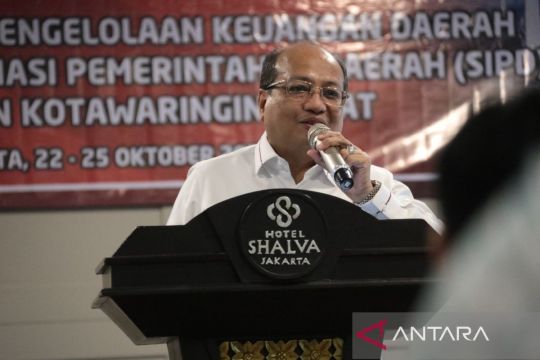
Jakarta (ANTARA) - Kementerian Dalam Negeri (Kemendagri) melalui Direktorat Jenderal (Ditjen) Bina Keuangan Daerah (Keuda) menegaskan pentingnya implementasi Sistem Informasi Pemerintahan Daerah (SIPD) Republik Indonesia (RI) dalam pengelolaan keuangan daerah oleh pemerintah daerah (Pemda).
Plh. Direktur Jenderal (Dirjen) Bina Keuda Horas Maurits Panjaitan berharap langkah ini dapat meningkatkan kinerja serta akuntabilitas pemerintah dalam mendukung tercapainya program nasional, mempercepat penerapan Sistem Pemerintahan Berbasis Elektronik (SPBE) dan Satu Data Indonesia.
Dia menekankan pentingnya peningkatan kapasitas dan akuntabilitas dalam pengelolaan keuangan daerah. "Kegiatan ini bertujuan untuk meningkatkan kapasitas di bidang pengelolaan keuangan daerah dengan mengimplementasikan penggunaan SIPD RI," kata Maurits dalam keterangannya di Jakarta, Kamis.
Ia juga menegaskan Kemendagri memegang peran strategis dalam melakukan pembinaan dan pengawasan umum terhadap penyelenggaraan pemerintahan daerah, sesuai amanat Undang-Undang (UU) Nomor 23 Tahun 2014 tentang Pemerintahan Daerah.
Dalam hal ini, pemda diwajibkan menyediakan informasi pemerintahan daerah yang dikelola dalam suatu sistem informasi.
"Berdasarkan Undang-Undang Nomor 23 Tahun 2014 Pasal 391, pemerintah daerah wajib menyediakan informasi pemerintahan daerah yang dikelola dalam suatu sistem informasi pemerintahan daerah. (Kemudian pada) Pasal 395 pemerintah daerah dapat menyediakan dan mengelola informasi pemerintahan daerah lainnya," tambahnya.
Maurits juga menekankan pentingnya tata kelola keuangan daerah, mulai dari pendapatan, belanja, hingga penyusunan laporan pertanggungjawaban dengan menggunakan SIPD RI.
"SIPD RI memiliki banyak kelebihan, seperti terintegrasi berdasarkan alur proses yang datanya mengalir dan terjadwal. Kemudian menggunakan bagan akun standar terbaru dan mengikuti regulasi terbaru. Seluruh data tercatat secara lengkap dan terkini, serta diinformasikan kepada perangkat daerah secara transparan mulai dari penyusunan perencanaan, penganggaran, penatausahaan, akuntansi, hingga pelaporan," jelas Maurits.
0 notes
Text
Lembaga kajian Indonesia (LKI)
Lembaga Kajian Indonesia (LKI) — LKI adalah Singkatan Dari Lembaga Kajian Indonesia, Lembaga ini didirikan di kota Pekanbaru, Provinsi Riau pada Tanggal 3 Bulan Januari tahun 2008 sampai dengan sekarang.
LKI juga sudah mengembangkan sayapnya dari Lembaga yang fokus mengembangkan sumberdaya manusia (SDM) di daerah dan sekarang sudah hampir seluruh indonesia
Lembaga Kajian Indonesia (LKI) sendiri bergerak dibidang Pendidikan dan Pelatihan Untuk Pegawai Negeri Sipil (PNS), Honorer / PPPK /pegawai yang diangkat berdasarkan perjanjian kerja dengan jangka waktu tertentu.
Visi dan Misi
mencerminkan suatu keinginan dan cita-cita untuk menjadi yang terdepan dalam melanjutkan perjalanan organisasi sebagai motor penggerak perubahan dalam penyelenggaraan pendidikan dan pelatihan non formal ke arah yang lebih baik, serta cerminan komitmen organisasi sebagai elemen penggerak dan motivator untuk menjadi semakin baik, yang harus disinergikan dengan elemen penggerak lainnya dalam suatu kesisteman yang utuh.
MISI
Misi Lembaga Kajian Indonesia yang di emban adalah:
Mendorong peningkatan kemampuan sumber daya melalui Bimbingan Teknis (Bimtek),/ Sosialisasi, Mendorong peningkatan pendidikan dan pelatihan (Diklat), Sosialisasi, dan pemahaman informasi.;
Bersama masyarakat dan institusi lainnya memberikan kontribusi terhadap terciptanya pemerintahan yang bersih dan berwibawa;
Meningkatkan pemberdayaan masyarakat melalui konsultasi publik atas setiap kebijakan yang akan diterapkan, dan Mendorong lahirnya inisiatif, kreatif dan kemandirian masyarakat;
Meningkatkan sumber daya manusia melalui pelatihan yang dilakukan;

Badan Hukum
Lembaga kajian indonesia (LKI) sebagai lembaga yang taat atas peraturan pemerintah dalam pengembangan Sumber daya Manusia (SDM) baik untuk Aparatur Sipil Negara (ASN), Honorer / PPPK /pegawai yang diangkat berdasarkan perjanjian kerja dengan jangka waktu tertentu maupun swasta. haruslah memiliki badan hukum yang jelas.
Berikut ini adalah beberapa Badan Hukum Lembaga Kajian Indonesia (LKI), yaitu sebagai berikut;
SK. Terdaftar Kemendagri RI. NO.0600–00–00/0133/V/2021
Nomor Ijin Berusaha (NIB) №0220001531536
SK Akreditasi B Deputi PPSDM LKPP №60 Tahun 2016
NPWP Nomor: 02.873.439.0–211.000.
SKT Kemenkeu RI Dirjen Pajak. №28/WPJ.02/KP.0303/2008.
Akte Notaris Dariyun Effendi, SH, Nomor -01-, 3 Januari 2008.
Berikut ini adalah beberapa materi bimtek/diklat yang kami tawarkan kepada bapak/ibu , yaitu sebagai berikut;
KUMPULAN MATERI BIMTEK
BIMTEK KEUANGAN
Berikut ini adalah beberapa materi bimtek/diklat keuangan, antara lain yaitu;
BIMTEK SIPD RI SERTA RENCANA KERJA OPD/SKPD DAN RENCANA KERJA PEMERINTAH DAERAH
BIMTEK PERMENDAGRI 77 TAHUN 2020 TENTANG PEDOMAN TEKNIS PENGELOLAAN KEUANGAN DAERAH
BIMTEK ADMINISTRASI KEUANGAN, PERENCANAAN, PENGANGGARAN, PELAKSANAAN, PENATAUSAHAAN DAN PERTANGGUNGJAWABAN PENGELOLAAN KEUANGAN
PENGELOLAAN KEUANGAN BAGI BENDAHARA PENERIMAAN DAN PENGELUARAN SERTA TATA CARA PENATAUSAHAAN DAN PENYUSUNAN LAPORAN PERTANGGUNG JAWABAN BENDAHARA SERTA PENYAMPAIANNYA
BIMTEK REKONSILIASI DAN VERIFIKASI TERHADAP LAPORAN PERTANGGUNGJAWABAN BENDAHARA OPD/SKPD
BIMTEK MANAJEMEN RESIKO ATAU PERENCANAAN ANGGARAN BERBASIS RESIKO
PENYUSUNAN LAPORAN KEUANGAN PEMERINTAH DAERAH (LKPD)
BIMTEK TATA CARA MENGANTISIPASI PEMERIKSAAN OLEH BPK-RI, SERTA SISTEM PENGENDALIAN INTERNAL DAN EKSTERNAL PEMERINTAH DAERAH
BIMTEK PENATAUSAHAAN DAN PENYUSUNAN LAPORAN PERTANGGUNGJAWABAN BENDAHARA
BIMTEK SISTEM ADMINISTRASI KEUANGAN DAN PERENCANAAN BAGI PENGUNA ANGGARAN PA, PPTK, PPK DAN BENDAHARA
Untuk Materi Bimtek/Diklat Keuangan Lebih Lengkap Silahkan Klik Disini…
BIMTEK KEPEGAWAIAN
Berikut ini adalah beberapa materi bimtek/diklat Kepegawaian, antara lain yaitu;
BIMTEK UU ASN NO. 20 TAHUN 2023 TENTANG APARATUR SIPIL NEGARA
BIMTEK KEBIJAKAN MANAJEMEN PNS DAN MANAJEMEN PPPK BERDASARKAN UNDANG-UNDANG (UU) ASN NO. 20 TAHUN 2023 SERTA TATA CARA SINKRONISASI RENCANA KERJA BIDANG MANAJEMEN APARATUR SIPIL NEGARA (ASN)
BIMTEK TATA CARA PERHITUNGAN ANGKA KREDIT SESUAI PERATURAN BKN TERBARU
BIMTEK PENILAIAN PRESTASI KERJA PNS DAN PENYUSUNAN SASARAN KERJA PEGAWAI (SKP)
BIMTEK ANALISIS JABATAN (ANJAB), ANALISIS BEBAN KERJA (ABK) DAN SOP APARATUR SIPIL NEGARA
BIMTEK PENYUSUNAN EVALUASI JABATAN DAN PENYUSUNAN STANDAR KOMPETENSI JABATAN DI LINGKUNGAN INSTANSI PEMERINTAH
BIMTEK MANAJEMEN KINERJA PNS DAN PENYUSUNAN SKP DAN PENILAIAN KINERJA PNS BERDASARKAN PERATURAN MENTERI PENDAYAGUNAAN APARATUR NEGARA DAN PENDAYAGUNAAN APARATUR NEGARA DAN REFORMASI BIROKRASI
BIMTEK MANAJEMEN KEPEGAWAIAN, SASARAN KERJA PEGAWAIAN NEGERI SIPIL (SKP) DALAM PENILAIAN PRESTASI KERJA PNS DAN ANALISIS KEPEGAWAIAN
BIMTEK TATA CARA PENGISIAN FORMULIR ANALISIS JABATAN (ANJAB) DAN ANALISIS BEBAN KERJA (ABK), PERHITUNGAN TINGKAT EFISIENSI DAN PRESTASI KERJA JABATAN/UNIT SERTA PENYUSUNAN DOKUMEN ANJAB DAN PETA JABATAN PADA PEMERINTAH PROVINSI/KOTA/KABUPATEN
BIMTEK PENGELOLAAN KEPEGAWAIAN BERBASIS APLIKASI E-KINERJA
Untuk Materi Bimtek/Diklat Kepegawaian Lebih Lengkap Silahkan Klik Disini…
BIMTEK BARANG MILIK DAERAH / ASET DAERAH
Berikut ini adalah beberapa materi bimtek/diklat Barang Milik Daerah / Aset Daerah, antara lain yaitu;
BIMTEK PERMENDAGRI NO.7 TAHUN 2024 PENGGANTI PERMENDAGRI 19 TAHUN 2016 TENTANG PEDOMAN PENGELOLAAN BARANG MILIK DAERAH
BIMTEK PENYUSUNAN ANALISIS KEBUTUHAN BARANG MILIK DAERAH DAN RENCANA KEBUTUHAN BARANG MILIK DAERAH (RKBMD)
BIMBINGAN TEKNIS AKUNTASI ASET TETAP DAN PENYUSUSNAN ASET TETAP SERTA SISTEM DAN TATA CARA PENGHAPUSAN ASET DAN PEMINDAHTANGANAN BARANG MILIK DAERAH
BIMTEK PENGELOLAAN DAN PERTANGGUNGJAWABAN KEUANGAN DAERAH DAN ASET DAERAH BERBASIS APLIKASI E-SIKAP, E-REPORTING, E-SIAP BMD
BIMBINGAN TEKNIS PENGELOLAAN DAN PENATAUSAHAAN BARANG ATAU ASET MILIK DAERAH SERTA STRATEGI MENUJU LAPORAN KEUANGAN WAJAR TANPA PENGECUALIAN (WTP)
BIMTEK TATA CARA PELAKSANAAN, PEMBUKUAN, INVENTARISASI, DAN PELAPORAN BARANG MILIK DAERAH BERDASARKAN PERATURAN PEMERINTAH DALAM NEGERI (PERMENDAGRI)
BIMBINGAN TEKNIS MANAJEMEN ASET DAERAH DAN INVENTARISASI ASET DALAM UPAYA PENGELOLALAAN ASET DAERAH, AKUNTANSI PENYUSUTAN ASET DAN PENGHAPUSAN ASET SERTA PERTANGGUNGJAWABAN ASET DAERAH
BIMTEK AUDIT BARANG MILIK DAERAH
BIMTEK SISTEM INFORMASI MANAJEMEN ASET DAERAH (SIMBADA) MEWUJUDKAN GOOD GOVERNANCE
BIMTEK PENGURUS BARANG OPD DALAM PENGELOLAAN BARANG MILIK DAERAH DAN PENYUSUNAN LAPORAN KEUANGAN PEMERINTAH DAERAH
Untuk Materi bimtek/diklat Barang Milik Daerah / Aset Daerah Lebih Lengkap Silahkan Klik Disini…
BIMTEK PERENCANAAN
Berikut ini adalah beberapa materi Bimtek/Diklat Perencanaan, antara lain yaitu;
Bimtek Laporan Akuntabilitas Kinerja Pemerintah Daerah (LAKIP), Rencana Strategis (RENSTRA), dan Rencana Kerja (RENJA)
Bimtek Rencana Strategis (RENSTRA) dan Rencana Kerja (RENJA) Pemerintah Daerah
Bimtek Penyusunan Rencana Pembangunan Jangka Panjang Daerah (RPJPD), Rencana Pembangunan Jangka Menengah Daerah (RPJMD) dan Penyusunan Renstra dan Renja SKPD/OPD serta Tata Cara Penyusunan RKA dan DPA SKPD/OPD
Bimtek Penyusunan Rencana Kerja Pemerintah Daerah (RKPD)
Bimtek Perencanaan, Pengendalian dan Evaluasi Pembangunan, Tata cara Evaluasi Raperda tentang RPJP Daerah dan RPJM Daerah serta Perubahan RPJP Daerah, RPJM Daerah dan RKP daerah
Bimtek Tata Cara Penyusunan Indikator Kinerja Utama (IKU) dan Penyusunan Laporan Akuntabilitas Kinerja Instansi Pemerintah (LAKIP) Untuk Penguatan Kapasitas Kinerja SKPD/OPD
Bimtek Perencanaan Pembangunan Daerah Berbasis E-Planning
Bimtek Keuangan dan Perencanaan Bagi Pengguna Anggaran (PA), Pejabat Pelaksana Teknis Kegiatan (PPTK), Pejabat Pembuat Komitmen (PPK) dan Bendahara
Bimtek Tata Cara Penyusunan, Pengendalian dan Evaluasi Rencana Kerja Pemerintah Daerah dan Rencana Kerja dan Anggaran (RKPD — RKA )
Bimtek Penyusunan, Pengajuan, Penetapan dan Perubahan Rencana Bisnis Anggaran (RBA) dan Rencana Strategi Bisnis (RSB) pada Badan Layanan Umum Daerah (BLUD)
Untuk Materi Bimtek/Diklat Perencanaan Lebih Lengkap Silahkan Klik Disini…
BIMTEK PENGADAAN BARANG DAN JASA
Berikut ini adalah beberapa materi Bimtek/Diklat Pengadaan Barang dan Jasa, antara lain yaitu;
Bimtek dan Ujian Sertifikasi Pengadaan Barang dan Jasa (PBJ)
Bimtek Percepatan Pelaksanaan Pengadaan dan Mitifasi Resiko Pengadaan
Bimtek Pengadaan Barang dan Jasa BLUD
Strategi dan Menajemen Pengelolaan Pengadaan Barang dan Jasa
Peningkatan Tata Kelola UKPBJ
Bimtek Penyusunan Kontrak dan Strategi Pengadaan Serta Audit Pengadaan Barang dan Jasa
Bimtek Analisis Harga Satuan Pekerjaan (AHSP)
Bimtek Analisis Pasar dan Penyusunan KAK (Kerangka Aceuan Kerja) serta Teknis Penyusunan HPS (Harga Perkiraan Sendiri)
Bimtek E-Purchasing dan Pengadaan Langsung Pengadaan Barang/Jasa
Bimtek Evaluasi Kewajaran Harga (EKH) dan Teknik Perhitungan Tingkat Komponen Dalam Negeri (TKDN)
Untuk Materi Bimtek Pengadaan Barang dan Jasa Pemerintah Lebih Lengkap Silahkan Klik Disini…
Bimtek Badan layanan Umum (BLUD)
Berikut ini adalah beberapa materi Bimtek/Diklat Badan layanan Umum (BLUD), antara lain yaitu;
Bimtek Keuangan Badan Layanan Umum Daerah (BLUD)
Bimtek Manajemen Rumah Sakit Badan Layanan Umum Daerah (BLUD)
Bimtek Rencana Bisnis Anggaran (RBA)
Bimtek Pengelolaan Dana Kapitasi Jaminan Kesehatan Nasional (JKN)
Bimtek Standar Pelayanan Minimum (SPM)
Bimtek Etika Pelayanan Rumah Sakit
Bimtek Manajemen Resiko di Rumah Sakit
Bimtek Strategi dan Manajemen Pengelolaan PBJ Sektor Kesehatan
Bimtek Pengadaan Barang dan Jasa Pemerintah Badan Layanan Umum Daerah (BLUD)
Bimtek Percepatan Penurunan STUNTING untuk Mencapai Target Tujuan Pembangunan Berkelanjutan
Untuk Materi Bimtek Badan layanan Umum (BLUD) Lebih Lengkap Silahkan Klik Disini…
BIMTEK PUSKESMAS
Berikut ini adalah beberapa materi Bimtek/Diklat PUSKESMAS, antara lain yaitu;
Bimtek Penerapan Sistem, Tata Kelola dan Pengelolaan Keuangan BLUD pada PUSKESMAS
Bimtek Penatausahaan Keuangan PPK — BLUD
Bimtek Penyusunan Keuangan PPK BLUD Puskesmas dengan (SAP) Standar Akuntansi Pemerintah Berbasis Akrual dan Laporan Realisasi Anggaran (LRA)
Bimtek Pengelolaan Keuangan, RBA, SPM dan Tata Kelola Badan Layanan Umum Daerah (BLUD)
Bimtek Pengelolaan Keuangan serta Perencanaan dan Penyusunan Anggaran Berbasis Kinerja Dalam Rangka Persiapan Badan Layanan Umum (BLUD)
Bimtek Rencana Bisnis Anggaran (RBA) pada Puskesmas
Bimtek Rencana Strategi Bisnis (RSB) dan Rencana Bisnis Anggaran Badan Layanan Umum Daerah (BLUD)
Bimtek Pengelolaan, Pemanfaatan, Penatausahaan dan Pertanggungjawaban Keuangan Dana Kapitasi Jaminan Kesehatan Nasional (JKN) dan Bantuan Operasional Kesehatan (BOK)
Bimtek Tata Cara Penyusunan, Pengajuan, Penetapan dan Perubahan Rencana Bisnis dan Anggaran pada Badan Layanan Umum Daerah (BLUD)
Bimtek Manajemen Puskesmas
Untuk Materi Bimtek PUSKESMAS Lebih Lengkap Silahkan Klik Disini…
BIMTEK PERPAJAKAN
Berikut ini adalah beberapa materi Bimtek/Diklat Perpajakan, antara lain yaitu;
Bimtek Pajak dan Retribusi Daerah
Bimtek Optimalisasi Pemungutan dan Penggalian Pajak Daerah dalam Meningkatkan Pendapatan Asli Daerah
Bimtek Tata Cara Pemungutan Pajak Pertambahan Nilai Barang dan Jasa, Serta Tata Cara Pemenuhan Hak dan Kewajiban Perpajakan Bagi Bendaharan dan PPTK dalam Pengadaan Barang/Jasa Milik Daerah
Bimtek Tata Cara Pemungutan Pajak Daerah dan Evaluasi Rancangan Peraturan Daerah Tentang Pajak Daerah dan Rancangan Peraturan Daerah Tentang Retribusi Daerah
Bimtek Pengelolaan Potensi Pajak dan Retribusi Daerah untuk Meningkatkan Pendapatan Asli Daerah (PAD) dan Teknis Penyusunan Model Pelayanan Publik Berkualitas dan Model Pelayanan Publik Bagi Pemerintah Daerah
Bimtek Mekanisme Pengendalian dan Evaluasi terhadap penerimaan Pendapatan Asli Daerah (PAD)
Bimtek Administrasi Perpajakan Instansi Pemerintah
Bimtek Audit Perpajakan
Bimtek Pemeriksanaa Pajak Daerah
Bimtek Kewajiban Perpajakan Bagi Bendahara Instansi Pemerintah
Untuk Materi Bimtek PUSKESMAS Lebih Lengkap Silahkan Klik Disini…
Bimtek Desa
Berikut ini adalah beberapa materi Bimtek/Diklat Desa, antara lain yaitu;
Bimtek Prioritas Pengunaan Dana desa
Bimtek Penyusunan Renstra Desa, RKP Desa dan APBDesa
Bimtek RPJMDes dan RKPDes
Bimtek Pengelolaan Badan Usaha Milik Desa (BUMDes)
Bimtek Badan Usaha Milik Bersama (BUMDESMA)
Bimtek Penyusunan Rencana Bisnis BUMDes
Bimtek Pemilihan Kepala Desa (PILKADES)
Bimtek Pengelolaan Keuangan Desa Berbasis SISKEUDES
Bimtek Pelaporan Dana ADD dan Bagi Hasil Pajak Retribusi Daerah
Bimtek Peranan Pemerintah Desa dalam Meningkatkan Partisipasi Masyarakat Desa
Untuk Materi Bimtek Desa Lebih Lengkap Silahkan Klik Disini…
Lembaga Kajian Indonesia (LKI)
Di atas adalah beberapa materi yang Lembaga Kajian Indonesia (LKI) tawarkan, sebenarnaya masih banyak lagi materi-materi lainnya… karena keterbatasan konten yang terlalu banyak jadi kami mengambil beberapa materi-materi pokoknya saja.
Baca Juga; Bimtek Keuangan 2024Bimtek Kepegawaian 2024Bimtek Perpajakan 2024Bimtek Perencanaan 2024Bimtek dan Ujian Pengadaan Barang dan Jasa 2024Bimtek Barang dan Aset Milik Daerah 2024Bimbingan Teknis Badan layanan Umum /Daerah BLU/BLUD 2024Bimtek Kearsipan 2024 support By
https://www.bimtekdiklat.co.id/
https://lembagakajianindonesia.or.id/
https://jadwalbimtekdiklatasn.com/
https://pusdiklatpemerintahanri.id/
1 note
·
View note
Text
Sight
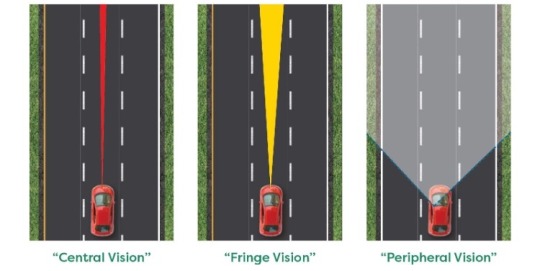
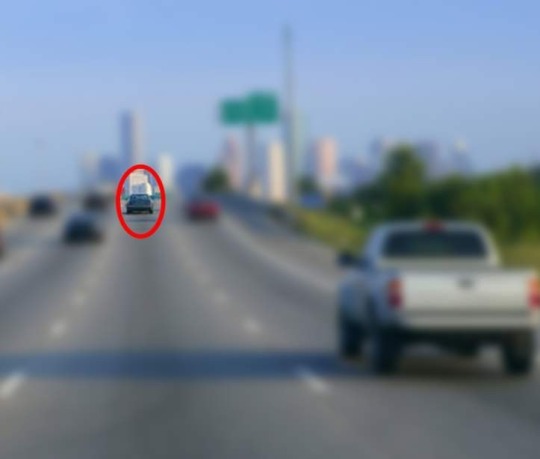
Central vision provides us with the greatest amount of detail of objects and conditions
It is the primary visual function used in targeting or looking specifically at one object or one area
It makes up 3% of a driver’s total visual field
For perspective, if you were to hold a dime at an arm’s length between your thumb and index finger, it would represent approximately 5 degrees of your visual field
Line of sight is the imaginary line extending from your eyes to a point of focus
It is central vision that allows us to have a line of sight, such as the line of sight from our eyes through the turn to where we will be in just a couple of seconds or the line of sight from our eyes down the road 20 to 30 seconds on a country road
Fringe Vision is used to judge depth and position
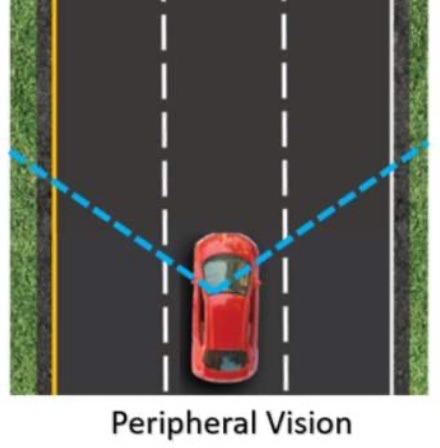
What is peripheral vision (also called “side” vision)?
Encompasses central and fringe vision as the broadest type of vision
Detects presence, color, and motion
Provides drivers with information about moving and stationary objects that could pose a threat
Gives a sense of speed
Provides drivers with a wide field of view
Field of view is the entire area of the road and surroundings that is visible to you at any given moment
It is peripheral vision that allows us to have a wide field of view
For most drivers, peripheral vision provides between 175 and 185 degrees of useful information
With our central vision being only 3% of our visual field, we have to rely on our peripheral vision to monitor the vast majority of any traffic scene
Perceive, Decide, Act (PDA) is a system to help drivers gather, filter, and act on driving information
IPDE
Identify → Predict → Decide →
Execute
SIPDE
Search – Identify → Predict →
Decide → Execute
SEE
Search → Evaluate → Execute

The 20- to 30-second visual lead
The 12- to 15-second visual control zone
The 4- to 6-second final response zone
Visual Control Zone
The 12- to 15-second visual control zone is the space you will drive through in the next 12 to 15 seconds
It represents the best area in which to adjust your speed and / or direction before it becomes too late
The visual control zone generally allows enough room to:
Smoothly accelerate
Slow down
Turn the steering wheel to move out of your lane to prevent conflict with other road users and avoid an unsafe situation
Smoothly respond to anything in your intended path, instead of reacting when you are closer to it
Final Response Zone
The 4- to 6-second final response zone represents the final opportunity to avoid a collision
It is also your last chance to steer to stay on your intended path of travel and reduce your speed quickly if your line of sight becomes blocked
If you don’t see something important until you’re in your final response zone, you will have to respond very quickly
The two components of a selective search pattern are:
Directing your search: know where to look, when, and for what
Classifying information: organizing the information in your brain and filtering it when necessary
Ground Viewing
Although your main visual lead area is up to 20 to 30 seconds down your path of travel, you should also be looking at the ground directly ahead and to the sides
This is called “ground viewing” and it can provide important information to support safe driving
Ground Viewing Benefits
Ground viewing can help you:
Judge another vehicle’s speed and any changes in speed
Determine whether other drivers are maintaining their lane positions or are about to change lanes
Determine whether other drivers are changing direction
Locate markings or unusual road conditions
Spot children, other pedestrians, and animals located behind or between parked cars
What are the four classifications of traffic elements you should search for?
Signs, signals, and road markings
Road features
Motorized vehicles
Non-motorized road users
An effective visual search strategy is:
To be searching 20 to 30 seconds ahead of your vehicle
Central Vision is the five-degree cone representing only 3% of a driver’s total visual field
Drivers should maintain a visual control zone of at least 12-15 seconds ahead
The most common form of color blindness is the inability to distinguish between: Red & Green
Visual Lead
The distance ahead that you search as you drive
2 notes
·
View notes
Text
High Doses of ADHD Drugs Linked to Greater Risk of Psychosis
There are concerns over the use of high dosages of ADHD medications, which are linked with an increased risk of psychosis. This has been brought up in an article by Akshay Syal called "High doses of ADHD drugs linked to greater risk of psychosis." Substance use, intoxication, or withdrawal are known to be direct causes of psychotic symptoms in substance-induced psychotic disorder (SIPD), a mental health illness (Nzima, 2024) (American Psychiatric Association, 2022). The symptoms of psychosis include delusions and hallucinations (Nzima, 2024) (American Psychiatric Association, 2022). This blog analyses the article's main ideas and explores how the findings apply to South Africa's healthcare system.
Although these drugs work well to control the symptoms of ADHD, excessive dosages might have negative side effects. The way that ADHD drugs function is by boosting specific brain chemicals. Overdosing may cause the brain to become overstimulated, potentially resulting in psychotic symptoms. To understand how large doses of these drugs might result in such symptoms, more research is required. For many people, ADHD drugs are crucial because they enhance their capacity to function and control symptoms. But because large doses of these drugs might cause psychosis, medical professionals need to carefully weigh the advantages of these drugs against their possible drawbacks. These dangers can be decreased by monitoring patients and modifying dosages. (Syal, 2024).
It's important to inform patients about the potential negative effects of their drugs, such as the possibility of psychosis from excessive dosages. Patients can avoid major side effects by using this information to identify and report any unexpected symptoms as soon as they occur.
In South Africa, there is an increasing awareness of mental health; however, challenges remain. Improved patient and healthcare provider education regarding the dangers of high doses of ADHD drugs is necessary. Patients should be made aware of the significance of sticking to their prescription instructions, and providers should get training on how to identify and treat medication-induced psychosis.
In South Africa, cultural beliefs can also impact the way that psychosis and ADHD are seen and handled. It's possible that some people favour traditional medicine or won't follow medical advice. When developing treatment strategies, healthcare professionals must be aware of and respectful of different cultural viewpoints.
Akshay Syal’s article about high doses of ADHD medications and psychosis highlights important issues for ADHD treatment. For South Africa, this means focusing on better healthcare access, improving mental health education, and considering cultural factors. By addressing these areas, South Africa can enhance the safety and effectiveness of ADHD treatments and better protect patients from potential risks.

(Rucker, 2024)
References:
American Psychiatric Association. (2022). Diagnostic and Statistical Manual of Mental Disorders Fifth edition text Revision. MrEdsCircleofTrust. https://www.mredscircleoftrust.com/storage/app/media/DSM%205%20TR.pdf
Nzima, N. (2024). Substance-Induced Psychotic Disorder [Slide show; Lecture Notes].
Rucker, K. (2024). High doses of ADHD medication linked to increased risk of psychosis. In Straight Narrow News. https://www.google.com/url?sa=i&url=https%3A%2F%2Fsan.com%2Fcc%2Fhigh-doses-of-adhd-medication-linked-to-increased-risk-of-psychosis%2F&psig=AOvVaw30FlD2Ekoic4FiKvbxASPO&ust=1726604580596000&source=images&cd=vfe&opi=89978449&ved=0CBQQjRxqFwoTCODUsrqlyIgDFQAAAAAdAAAAABAQ
Syal, A. (2024, September 12). High dosages of ADHD drugs may increase risk of psychosis [Video]. NBC News. https://www.nbcnews.com/health/mental-health/high-doses-adhd-drugs-linked-greater-risk-psychosis-rcna170707
0 notes
Link
Pada hari Selasa, 13 Agustus 2024, rapat asistensi terkait Penerapan e-BMD dalam Sistem Informasi Pemerintahan Daerah Republik Indonesia (SIPD RI) dan percepatan pelaksanaan penataan barang milik daerah dilaksanakan secara daring melalui Zoom Meeting. Acara ini menghadirkan berbagai narasumber kompeten di bidangnya, termasuk Budi Ernawan, yang menjabat sebagai Plh. Direktur BUMD, BLUD, dan BMD Ditjen Bina Keuda Kemendagri, serta Ir. Amanah, Kasubdit Barang Milik Daerah Wilayah I Ditjen Bina Keuda Kemendagri. Selain itu, hadir pula Hendra Wijaya dari Tim Ahli LPPSSP Universitas Indonesia sebagai pembicara, serta Jona Maria Mantow yang bertindak sebagai moderator.
1 note
·
View note
Text
LKPD Berkendala, Pemda Boalemo Gerak Cepat Lakukan Pertemuan
HIMPUN.ID – Penjabat Sekretaris Daerah Kabupaten Boalemo Supandra Nur menuturkan, dalam penyusunan Laporan Keuangan Pemerintah Daerah (LKPD) masih terdapat kendala-kendala yang di hadapi OPD dalam Proses perekaman dari SIPD ke FMIS. Menangani hal tersebut, Pemerintah Daerah (Pemda) Boalemo bergerak cepat melakukan pertemuan dengan para pimpinan OPD yang ada di Lingkungan Pemda Boalemo. “Rapat ini…
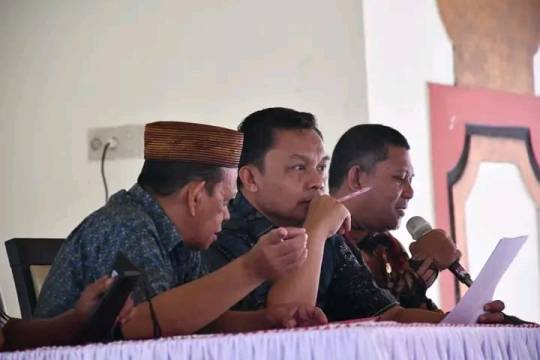
View On WordPress
0 notes
Text
Pemerintah Provinsi Bali kembali Raih Predikat Sangat Baik dalam Evaluasi SPBE Tahun 2023
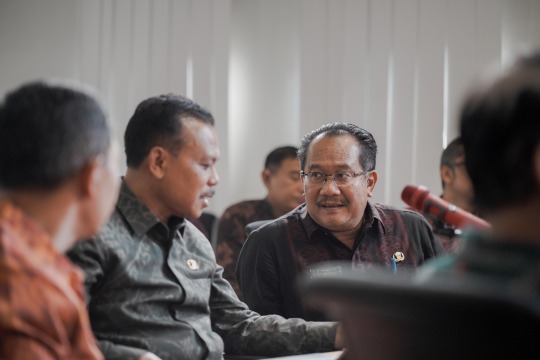
BALIPORTALNEWS.COM, DENPASAR - Pemerintah Provinsi Bali kembali meraih predikat "Sangat Baik" dalam evaluasi penyelenggaraan Sistem Pemerintahan Berbasis Elektronik (SPBE) tahun 2023. Indeks SPBE Pemerintah Provinsi Bali juga mengalami peningkatan yang signifikan, melonjak dari 3,68 pada tahun 2021 menjadi 4,07 dari skala 5,0 poin tertinggi pada tahun 2023. Penetapan ini diumumkan melalui Keputusan Menteri Pendayagunaan Aparatur Negara dan Reformasi Birokrasi Republik Indonesia Nomor 13 Tahun 2024, yang diumumkan pada Jumat (12/1/2024). Prestasi ini juga diikuti oleh tiga Pemerintah Daerah lainnya di Bali, yang turut meraih prestasi dengan predikat "Sangat Baik," yaitu Pemerintah Kota Denpasar (Indeks SPBE 3,80), Pemerintah Kabupaten Tabanan (Indeks SPBE 3,77) dan Pemerintah Kabupaten Badung (Indeks SPBE 3,66). Sementara itu, Pemerintah Buleleng (Indeks SPBE 3,45), Pemerintah Kabupaten Jembrana dan Gianyar (Indeks SPBE 3,14), dan Pemerintah Kabupaten Klungkung (Indeks SPBE 3,02) meraih predikat "Baik." Pemerintah Pemerintah Kabupaten Bangli (Indeks SPBE 2,48) dan Kabupaten Karangasem (Indeks SPBE 2,30) mendapatkan predikat "Cukup." “Indeks SPBE yang tinggi merupakan indikator penting dalam tata kelola pemerintahan yang bersih, efektif, transparan, dan akuntabel. Indeks ini juga erat kaitannya dengan peningkatan kualitas layanan publik melalui penerapan sistem pemerintahan berbasis elektronik,” kata Sekretaris Daerah Provinsi Bali, Dewa Made Indra dalam siaran persnya di Denpasar, Minggu (14/1/2024). Evaluasi ini mencakup empat domain utama, yaitu Kebijakan, Tata Kelola, Manajemen, dan Layanan, yang terdiri dari delapan aspek dan 47 indikator penilaian. Delapan aspek dimaksud mencakup Kebijakan Tata Kelola dan Perencanaan Strategis SPBE, Tata Kelola TIK dan Penyelenggara SPBE, Manajemen Penerapan SPBE dan Audit TIK serta tingkat penyelenggaraan Layanan Administrasi Pemerintahan dan Layanan Publik Berbasis Elektronik. “Keberhasilan ini mencerminkan kolaborasi yang erat antar instansi di Pemerintah Provinsi Bali, serta adanya pengawasan dan evaluasi yang berkelanjutan,” ujar Sekda Dewa Indra Tak hanya itu, Pemerintah Provinsi Bali telah berhasil mengintegrasikan layanan dengan berbagai entitas, termasuk Layanan Pemerintah Pusat, seperti Satu Data Indonesia, Sistem Informasi Pembangunan Daerah (SIPD), dan Layanan Aspirasi dan Pengaduan Online Rakyat (LAPOR!). Selain itu, layanan kepegawaian yang terintegrasi dengan platform digital manajemen ASN (SI ASN) juga menjadi bagian dari capaian ini. Bali juga menjalin kerjasama dengan Pusat Data Nasional (PDN) untuk memaksimalkan pemanfaatan infrastruktur dan layanan yang ada. Penerapan Layanan Single Sign-On (SSO) di Pemerintah Provinsi Bali juga diakui sebagai best practice, bahkan menjadi acuan bagi beberapa Pemerintah Daerah di Indonesia. Saat ini, telah ada 57 layanan digital yang terintegrasi ke dalam SSO, dengan lebih dari 33 ribu pengguna yang terdaftar, termasuk Pemerintah Provinsi Bali, Pemerintah Daerah di Kabupaten/Kota di Bali, 1.500 Desa Adat di Bali, sejumlah fasilitas kesehatan di Bali, serta beberapa Instansi Pusat/Vertikal di Bali. Penerapan ini telah menarik perhatian sejumlah instansi lain di Indonesia untuk melakukan studi tiru di Bali. Diantaranya Pemerintah Provinsi Jawa Barat yang tertarik untuk menerapkan Sistem Penghubung Layanan Pemerintah (SPLP) dan mekanisme Layanan SSO di Bali untuk diterapkan di wilayah mereka. Bahkan, program Happy Digital X oleh Tsinghua University di United in Diversity Bali Campus (UIDBC) memasukkan penerapan Layanan SSO yang terintegrasi dengan Layanan Kepegawaian di Bali sebagai salah satu benchmarking dalam penerapan layanan serupa di Pemerintah Daerah lain, termasuk Pemerintah Kabupaten Sumedang. Evaluasi Sistem Pemerintahan Berbasis Elektronik tahun 2023 melibatkan 621 Instansi Pusat dan Pemerintah Daerah, dengan tahapan evaluasi yang dimulai sejak Juni 2023. Prosesnya mencakup sosialisasi, penilaian mandiri, penilaian interviu, dan penilaian visitasi secara selektif. Penilaian mandiri dilaksanakan dengan intensitas tinggi yang melibatkan seluruh unit Perangkat Daerah di Pemerintah Provinsi Bali. Selanjutnya, penilaian interviu dilaksanakan secara daring pada 26 September 2023 yang dipimpin langsung oleh Sekretaris Daerah Provinsi Bali, Dewa Made Indra, bertempat di Ruang SPBE Dinas Komunikasi, Informatika dan Statistik Provinsi Bali dengan partisipasi seluruh Perangkat Daerah Pemerintah Provinsi Bali. Sekda Dewa Indra mengatakan prestasi dengan Indeks SPBE sebesar 4,07 bukan hanya merupakan apresiasi, tetapi juga menjadi tantangan bagi seluruh Unit Perangkat Daerah di Pemerintah Provinsi Bali dan Pemerintah Daerah lainnya. “Pemerintah terus berupaya untuk meningkatkan kualitas pelayanan publik melalui perbaikan kebijakan, tata kelola yang lebih efisien, manajemen SPBE yang berkualitas, serta pemantauan dan evaluasi yang terus-menerus. Dengan demikian, Indeks SPBE diharapkan akan menjadi alat penting dalam menjaga tata kelola pemerintahan yang bersih, efektif, transparan, dan akuntabel bagi seluruh Instansi Pusat dan Pemerintah Daerah di Indonesia,” pungkasnya.(bpn) Read the full article
0 notes